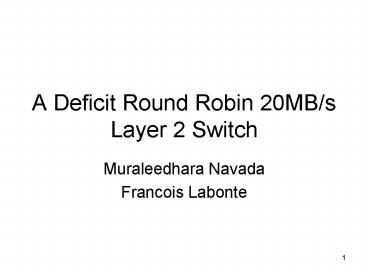A Deficit Round Robin 20MB/s Layer 2 Switch PowerPoint PPT Presentation
Title: A Deficit Round Robin 20MB/s Layer 2 Switch
1
A Deficit Round Robin 20MB/s Layer 2 Switch
- Muraleedhara Navada
- Francois Labonte
2
Fairness in Switches
Output Queued Switch
- How to provide fair bandwidth allocation at
output link ? - Simple FIFO favors greedy flow
- Separate flows into FIFOs at output
- Bit by Bit fair queuing
- Weighted Fair Queuing allows different weight for
flows - Packetized Weighted Fair Queuing (aka PGPS)
calculates departure time for each packet
50
100
50
50
50
50
50
50
150
Round-Robin bit by bit allocation
3
Deficit Round Robin
- Packetized Weighted Fair Queuing is complicated
to implement - Deficit Round Robin keeps track of credits for
each flow - Flow sends according credits
- Add credits according to weight
- Essentially PWFQ at coarser level
Credits
75
50
100
50
50
50
75
75
50
50
50
75
150
Credits
75
50
100
Time
50
50
50
50
25
25
50
50
75
150
Credits
150
50
100
50
50
100
100
50
50
150
150
4
NetFPGA System
1MB SRAM
- 8 Port 10MB/s duplex ethernet
- Control FPGA (CFPGA) handles physical interface
(MAC) - Our design targets both the User FPGAs (UFPGA)
UFPGA1
CFPGA
10MB/s Ethernet
UFPGA0
1MB SRAM
1MB SRAM
5
Design Considerations
- 4 MACs behind each port (8)
- Each flow is a unique Source Address
Destination Address pair - 1024 flows
- Split across FPGAs
- Each UFPGAs read incoming packets from different
ports(0-3 and 4-7) - tradeoff between memory storage and fairness
across all flows
6
Memory Buffer Allocation
- Static Partitioning of 1MB SRAM across 512 flows
gives 2kbytes per flow lt 2 max size packets - Need more dynamic allocation
- Segments smaller size means less fragmentation,
but more pointer and list handling overhead - 128 bytes was chosen
- Keep free segments list
- Save on-chip only pointer to head and tail of
each flow
P1
P1
P2
P3
P4
P5
P5
P6
7
MAC address Learning
- Instead of telling which MAC addresses belong to
which port - Learn them from the source address
- Note that our split FPGA design (reading from
different ports) require them to communicate the
MACs learned between them - When destination MAC is not learned yet,
broadcast (send to all other ports). - So MAC learning implies broadcast capability
8
Read Operation
Share SA
Master Control
Read, port
MAC Learning Flow Assignment
CFPGA Interface
Control Handler
DA, SA
Flow ID
Packet Memory Manager
DRR Engine
Flow Tail
Length, ptr
1 MB SRAM
9
Write Operation
Master Control
Write, port
MAC Learning Flow Assignment
CFPGA Interface
Port REQ
Control Handler
Port GNT
Data Ready
Packet Memory Manager
DRR Engine
Head, length
Next head, length, latency
1 MB SRAM
10
DRR Engine
- How to handle 512 flows and stay work conserving
- Only one flow active at any time
- DRR allocation happens on dequeuing
- Fifos contain the next flow to be serviced for
each port - Statistics per flow
- Weight
- Latency
- Byte sent
- Packet sent
- Packets active
11
Conclusion
- A Deficit Round Robin Switch with 1k flows has
been implemented - Provides dynamic memory buffer allocation, MAC
learning and broadcast - Parallel design split across 2 chips
- Gathers statistics on flows

